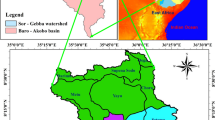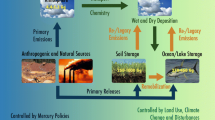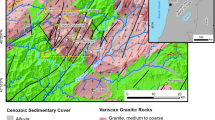Abstract
Precipitation samples of various spatio-temporal scales were collected from coastal, midland and urban regions of Greater Cochin, Ernakulam district, Kerala for a period of 1 yr (2015–2016). The collected samples were analysed for stable water isotopes (SWI) (δD and δ18O), to understand these variations in the precipitation source and the factors governing its isotopic characteristics during precipitation. The δ18O in rainwater varies from −8.73‰ to 0.29‰ in urban, −12.21‰ to 2.59‰ in midland and −9.99% to 0.97‰ in lowland regions. Spatio-temporal variations in SWI were observed in various regions, suggesting altitude and continental effect followed by the establishment of a regional overall local meteoric water line (LMWL) δD = 8.06 (±0.15) δ18O + 12.5 (±0.68). Among the coastal, midland and urban regions, the highest slope (~8.3) and intercept (~13.0) were observed in the urban region, which designates the variations in temperature along spatial and different layers of the atmosphere in the urban region, resulting in the deviation of isotopic characteristics. The overall deuterium excess (d-excess) value is ~10‰ during the south-west monsoon (June–September), suggesting a moisture source of marine origin. A d-excess of ~13‰ is observed during the north-east monsoon, indicating a moisture source from the continental contribution (October–December). The results of the moisture source obtained from the d-excess value are also supported by back-trajectory analysis. Thus, the present study on isotopic characterisation of precipitation and its controlling factor may enhance our understanding of the Indian monsoon and its dynamics in the west coast region of India.










Similar content being viewed by others
References
Aneesh T D, Srinivas R, Nair A M, Prasad K R, Arun T J and Ande B 2018 Estimation of runoff with respect to temporal and spatial land use changes in Cochin Urban Agglomerate, India: A case-study of 2018 flood; Int. J. Sci. Eng. Res. 9(11) 498–502, https://doi.org/10.14299/ijser20181010.
Central Ground Water Board (CGWB) (1995–2004) Annual report and other related reports Central Ground Water Board, New Delhi.
Chakraborty S, Sinha N, Chattopadhyay R, Sengupta S, Mohan, P M and Datye A 2016 Atmospheric controls on the precipitation isotopes over the Andaman Islands, Bay of Bengal; Sci. Rep. 6 19555, https://doi.org/10.1038/srep19555.
Clark I D and Fritz P 1997 Environmental isotopes in hydrogeology; Lewis Publishers, Boca Raton, pp. 40–108.
Craig H 1961 Isotope variations in meteoric waters; Science 133(3465) 1702–1703.
Dansgaard W 1964 Stable isotopes in precipitation; Tellus 16(4) 436–468, https://doi.org/10.3402/tellusav16i48993.
Deshpande R D, Bhattacharya S K, Jani R A and Gupta S K 2003 Distribution of oxygen and hydrogen isotopes in shallow groundwaters from Southern India: Influence of a dual monsoon system; J. Hydrol. 271(1–4) 226–239.
Deshpande R D, Maurya A S, Kumar B, Sarkar A and Gupta S K 2010 Rain-vapor interaction and vapor source identification using stable isotopes from semiarid western India; J. Geophys. Res. 115 D23311.
Draxler R R and Rolph G D 2003 HYSPLIT (HYbrid Single-Particle Lagrangian Integrated Trajectory) model access via NOAA ARLREADY website (http://www.arlnoaagov/ready/hysplit4html), NOAA Air Resources Laboratory, Silver Spring.
Eliasson I and Holmer B 1990 Urban heat island circulation in Göteborg, Sweden; Theor. Appl. Climatol. 42 187–196.
Eliasson I and Upmanis H 2000 Nocturnal airflow from urban parks – Implications for city ventilation; Theor. Appl. Climatol. 66 95–107.
Gammons C H, Poulson S R, Pellicori D A, Reed P J, Roesler A J and Petrescu E M 2006 The hydrogen and oxygen isotopic composition of precipitation, evaporated mine water, and river water in Montana, USA; J. Hydrol. 328(1–2) 319–330.
Gedzelman S, Lawrence J, Gamache J, Black M, Hindman E, Black R, Dunion J, Willoughby H and Zhang X 2003 Probing hurricanes with stable isotopes of rain and water vapor; Mon. Weather Rev. 131 1112–1127, https://doi.org/10.1175/1520-0493(2003)131%3c1112:PHWSIO%3e20CO;2.
Ghosh S K, Pant M C and Dewan B N 1978 Influence of the Arabian Sea on the Indian summer monsoon; Tellus 30(2) 117–125.
Good S P, Mallia D V, Lin J C and Bowen G J 2014 Stable isotope analysis of precipitation samples obtained via crowd sourcing reveals the spatiotemporal evolution of super storm sandy; PLoS One 9(3) 1–7, https://doi.org/10.1371/journalpone0091117.
Gonfiantini R 1986 Environmental isotopes in lake studies; In: Handbook of environmental isotope geochemistry (eds) Fritz P and Fontes J C, Elsevier, New York, Vol. 2, 113–168.
Gupta S K and Deshpande R D 2003 Synoptic hydrology of India from the data of isotopes in precipitation; Curr. Sci. 85(11) 1591–1595.
Gupta S K and Deshpande R D 2005 Groundwater isotopic investigations in India: What has been learned? Curr. Sci. 89(5) 825–835.
Hoffmann G, Cuntz M, Jouzel J and Werner M 2005 How much climate information bear the water isotopes? A systematic comparison between the IAEA/GNIP isotope network and the ECHAM4 Atmospheric General Circulation Model, pp. 303–320.
Houghton J T, Ding Y, Griggs D J, Noguer M and Linden P J V D 2001 Climate change 2001: The scientific basis; Cambridge University Press, Cambridge.
Hu C, Froehlich K, Zhou P, Lou Q, Zeng S and Zhou W 2013 Seasonal variation of oxygen-18 in precipitation and surface water of the Poyang Lake Basin, China; Isot. Environ. Health Stud. 49(2) 188–196.
Hunjak T, Lutz H O and Roller-Lutz Z 2013 Stable isotope composition of the meteoric precipitation in Croatia; Isot. Environ. Health Stud. 49(3) 336–345.
India Meteorological Department 2016 Meteorological Centre, Trivandrum, Kerala, http://www.imdtvmgovin.
Ingraham N L and Taylor B E 1986 Hydrogen isotope study of large-scale meteoric water transport in northern California & Nevada; J. Hydrol. 85 183–197.
Kuttler W and Romberg E 1992 The occurrence and effectiveness of country breeze by means of wind tunnel and in situ-measurements; In: Proceedings of the 9th World Clean Air Congress, Montreal, Quebec, Canada, August 30–September 4, IU-9A04, pp. 1–2.
Laskar A H, Sharma N, Ramesh R, Jani R A and Yadava M G 2010 Paleoclimate and paleo vegetation of lower Narmada Basin, Gujarat, Western India, inferred from stable carbon and oxygen isotopes; Quat. Int. 227 183–189, https://doi.org/10.1016/jquaint201005020.
Lekshmy P R, Midhun M, Ramesh R and Jani R A 2014 18O depletion in monsoon rain relates to large scale organized convection rather than the amount of rainfall; Sci. Rep. 4 5661.
Lekshmy P R, Midhun M and Ramesh R 2015 Spatial variation of amount effect over peninsular India and Sri Lanka: Role of seasonality; Geophys. Res. Lett. 42(13) 5500–5507, https://doi.org/10.1002/2015GL064517.
Mathieu R and Bariac T 1996 An isotopic study on water movements in clayey soils under semiarid climate; Water Resour. Res. 32 779–789.
Menon P A and Rajan C K 1989 Climate of Kerala, Cochin; Classic Publishing House, Cochin.
National Oceanic and Atmospheric Administration 2017 State of the climate in 2016, Special Supplement to the Bulletin of the American Meteorological Society, Vol. 98(8).
Oke T R 1981 Canyon geometry and the nocturnal urban heat island: Comparison of scale model and field observations; Climatology 1 237–254.
Oltmans S J and Hoffmann D J 1995 Increase in lower-stratospheric water vapor at a mid latitude Northern Hemisphere site from 1981 to 1994; Nature 374 146–149.
Purushothaman P, Rao M S, Kumar B, Rawat Y S, Krishan G and Devi P 2012 Comparison of two methods for ground level vapor sampling and influence of meteorological parameters on its stable isotopic composition at Roorkee, India; Hydrol. Processes 28(3) 882–894, https://doi.org/10.1002/hyp9623.
Rahul P, Ghosh P, Bhattacharya S K and Yoshimura K 2016 Controlling factors of rainwater and water vapor isotopes at Bangalore, India: Constraints from observations in 2013 Indian monsoon; J. Geophys. Res. Atmos. 121 13,936–13,952. https://doi.org/10.1002/2016JD025352.
Resmi T R, Sudharma K V and Hameed A S 2016 Stable isotope characteristics of precipitation of Pamba River basin, Kerala, India; J. Earth Syst. Sci. 125(7) 1481–1493.
Rhodes A L, Guswa A J and Newell S E 2006 Seasonal variation in the stable isotopic composition of precipitation in the tropical mountain forests of Monteverde, Costa Rica; Water Resour. Res. 42 W11402, https://doi.org/10.1029/2005WR004535.
Roderick M L and Farquhar G D 2002 The cause of decreased pan evaporation over the past 50 yrs; Science 298 1410–1411, https://doi.org/10.1126/science1075390.
Rozanski K, Sonntag G and Munnich K O 1982 Factors controlling stable isotope composition of European precipitation; Tellus 34 142–150.
Rozanski K, Araguás-Araguás L and Gonfiantini R 1993 Isotopic patterns in modern global precipitation; In: Climate change in continental isotopic records (eds) Swart P K, Lohmann K L, McKenzie J and Savin S, American Geophysical Union, Washington DC, pp. 1–37.
Salati E, Dall'Olio A, Matsui E and Gat J R 1979 Recycling of water in the Amazon Basin: An isotopic study; Water Resour. Res. 15 1250–1258.
Sanyal P and Sinha R 2010 Evolution of the Indian summer monsoon: Synthesis of continental records; J. Geol. Soc. London, Spec. Publ. 342(1) 153–183.
Saranya P, Krishan G, Rao M S, Kumar S and Kumar B 2018 Controls on water vapor isotopes over Roorkee, India: Impact of convective activities and depression systems; J. Hydrol. 557 679–687.
Schotterer U, Frohlich K and Gaggeler H W 1997 Isotope records from Mongolian and Alpine ice cores as climate indicators; Clim. Change. 36 519–530.
Simpkins W W 1995 Isotopic composition of precipitation in central Iowa; J. Hydrol. 172(1–4) 185–207.
Soman M K, Krishna K K and Singh N 1988 Decreasing trend in the rainfall of Kerala; Curr. Sci. 57 7–12.
Sonntag C, Rozanski K, Miinnich K O and Jacob H 1983 Variations of deuterium & oxygen-18 in continental precipitation & groundwater & their causes; In: Variations in the Global Water Budget (eds) Street-Perrott A et al., D. Reidel Publishing Company, pp. 107–124.
Spronken-Smith R A and Oke T 1998 The thermal regime of urban parks in two cities with different summer climates; Int. J. Remote Sens. 19(11) 2085–2104.
Stumpp C, Klaus J and Stichler W 2014 Analysis of long-term stable isotopic composition in German precipitation; J. Hydrol. 517 351–361.
Svensson M, Eliasson I and Holmer B 2002 A GIS-based empirical model to simulate air temperature variations in the Göteborg urban area during the night; Clim. Res. 22(3) 215–226.
Tremoy G, Vimeux F, Mayaki S, Souley I, Cattani O, Risi C, Favreau G and Oi M 2012 A 1-yr long d18O record of water vapor in Niamey (Niger) reveals insightful atmospheric processes at different timescales; Geophys. Res. Lett. 39 1–5, https://doi.org/10.1029/2012GL051298.
Trenberth K E 2002 Changes in tropical clouds and radiation; Science 296 2095, https://doi.org/10.1126/science29655762095a.
Unnikrishnan Warrier C and Babu M P 2011 A comparative study on isotopic composition of precipitation in wet tropic and semi-arid stations across southern India; J. Earth Syst. Sci. 120(6) 1085–1094.
Unnikrishnan Warrier C, Praveen Babu M, Manjula P, Velayudhan K T, Shahul Hameed A and Vasu K 2010 Isotopic characterization of dual monsoon precipitation – Evidence from Kerala, India; Curr. Sci. 98(11) 1487–1495.
Unnikrishnan Warrier C, Praveen Babu M, Sudheesh M and Deshpande R D 2015 Studies on stable isotopic composition of daily rainfall from Kozhikode, Kerala, India; Isot. Environ. Health Stud. 52(3) 219–230, https://doi.org/10.1080/1025601620161103238.
Upmanis H, Eliasson I and Lindqvist S 1998 The influence of green areas on nocturnal temperatures in a high latitude city (Göteborg, Sweden); Int. J. Climatol. 18 681–691.
Wassenaar L I, Athanasopoulos P and Hendry M J 2011 Isotope hydrology of precipitation, surface and ground waters in the Okanagan Valley, British Columbia, Canada; J. Hydrol. 411(1–2) 37–48.
Acknowledgements
This work is funded by the Ministry of Earth Sciences (MoES), Government of India through the National Centre for Earth Science Studies (NCESS), Kerala. The authors are thankful to the Director of National Centre for Earth Science Studies (NCEES) and Director of National Centre for Antarctic and Ocean Research (NCAOR). The authors also acknowledge Dr Thamban Meloth for his valuable suggestions and for allowing us to avail the laboratory facilities at NCAOR.
Author information
Authors and Affiliations
Corresponding author
Additional information
Communicated by Rajib Maity
Supplementary material pertaining to this article is available on the Journal of Earth System Science website (http://www.ias.ac.in/Journals/Journal_of_Earth_System_Science).
Electronic supplementary material
Below is the link to the electronic supplementary material.
Rights and permissions
About this article
Cite this article
Aneesh, T.D., Srinivas, R., Singh, A.T. et al. Stable water isotope signatures of dual monsoon precipitation: A case study of Greater Cochin region, south-west coast of India. J Earth Syst Sci 128, 210 (2019). https://doi.org/10.1007/s12040-019-1234-2
Received:
Revised:
Accepted:
Published:
DOI: https://doi.org/10.1007/s12040-019-1234-2




